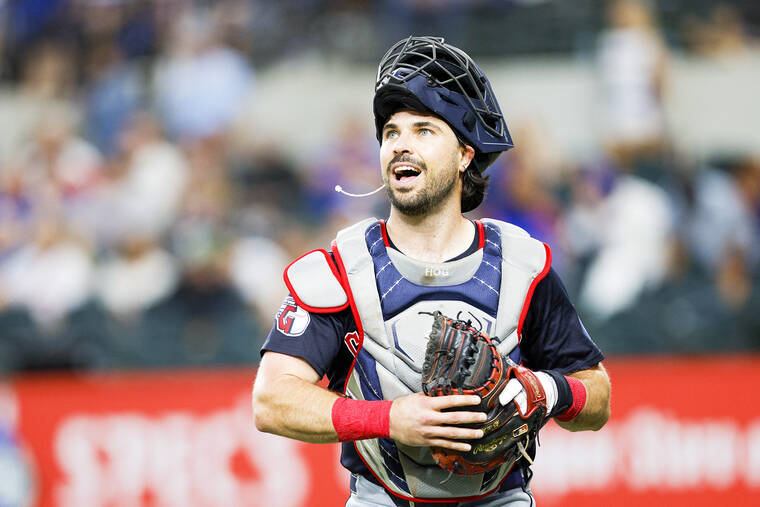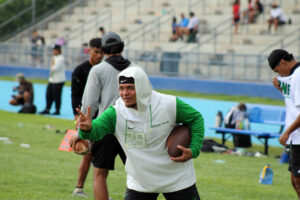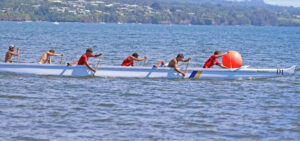In today’s game, more than before, catchers ‘have to enjoy the bruises’


Catching was a family tradition, so when Reese McGuire of the Boston Red Sox was 8 or 9, as he recalled, he tested out his new catching gear in the backyard on Christmas. As he crouched in the grass and baseballs caromed off his forearms, his grandfather told him: “It takes a tough kid to be a catcher. You have to enjoy the bruises.”
Arizona Diamondbacks catcher Tucker Barnhart, who has spent 11 seasons in the majors, said, “We’re all kind of crazy, I think, to get back there.”
ADVERTISING
Catching is not for the faint of heart — or thigh or wrist or toe or hip or knee or hand or shoulder.
Late last month, Los Angeles Angels catcher Logan O’Hoppe was dealing with a black-and-blue shoulder, leaving him hardly able to lift his arm after absorbing a foul ball. His backup, Matt Thaiss, had a bruised hand after catching José Soriano’s 98-mph sinkers. Then O’Hoppe left a game last week after taking a foul ball to the hand.
San Francisco Giants catcher Patrick Bailey took a foul ball last month on the exposed area of the toe where the foot shield does not quite reach. Three days later, he landed on the concussion injured list after taking a foul ball to the face mask. Red Sox catcher Connor Wong also recently dealt with a bruise under his toenail. Wong went on to describe a previous bruise to his quad, which made crouching painful. And, well, crouching is a key part of the job.
“It’s our duty to be that tank back there and roll with the punches,” Wong said.
For more than a century, catchers have accepted the bruises and strains that have come with the territory. But as the game evolves, the demands of the job are making it even more hazardous. Catchers have shifted closer to the plate to aid with pitch framing, but that has caused a rise in catcher interference calls and exposed catchers to more injuries.
Last week, St. Louis Cardinals catcher Willson Contreras was struck by the swing of the New York Mets’ J.D. Martinez and has a broken left arm from it.
“There’s always a risk being a catcher,” Contreras said after the injury. “Could have been something different. It could’ve been off my knee, it could be a concussion. That risk is always going to be there.”
Add it to the list. There is a reason Barnhart and others, including the Cleveland Guardians’ bench coach, Craig Albernaz, can be heard on the first day of spring training every year relaying a familiar message: It’s all downhill from here.
“The amount of excitement,” Barnhart said about the dawn of a new season, “and ‘Man, I feel great’ — and then Day 2 happens.”
They will not return to 100% until the depths of winter, after they have recovered from every foul tip, every sore muscle, every nick and bruise in every nook of the body. The job is unrelenting and unforgiving.
And yet, for a team to succeed, so much necessarily falls on a catcher’s sore shoulders. Catchers build a rapport with each pitcher. They know the pitchers’ tendencies and what has been clicking. They know how they have attacked certain hitters in the past. They see the scouting reports on every member of the opposing roster. That is quite a learning curve for any fill-in, and Barnhart said it is why catchers are so motivated to avoid time off.
Guardians catcher Austin Hedges scrolled through thousands of photos on his phone one day last week in search of evidence of the gnarliest bruise he could find. He located one that occupied nearly his entire right thigh, with rich shades of indigo, plum and mulberry. He shook his head and laughed. The culprit? One single foul tip.
“The foul balls seem to always hit you in a spot where you don’t have gear or have the least amount of gear,” Barnhart said.
In 2022, Hedges sprained an ankle while lunging toward first base. Two weeks after that healed, he suffered a high ankle sprain as he tumbled into the dugout trying to corral a pop-up. His heel turned a dark violet and his ankle ballooned in size. He struggled to rotate while batting. He could not comfortably position himself behind the plate or push off his backside, which resulted in him long-hopping the ball to second when trying to nab a base runner.
“You’re in pain, but you never get to shut it off,” Hedges said. “If you can play, you play. There’s no hesitation. You see how people react to getting hit by pitches. It doesn’t feel a whole lot better getting a foul tip off flesh. Then you just have to come back and act like it’s not even a thing.”
Albernaz thought his playing career was over when loose bodies in his knee kept getting wedged in his joint and leaving him unable to crouch. One of his fellow coaches in Cleveland, Sandy Alomar Jr., lasted 20 years as a major league catcher. Alomar underwent six surgeries on his left knee and three on his right.
“If you want to be a catcher,” Alomar said, “you’re never going to be 100%. Ever.”
Even now, he has a bone spur in his left foot from years of absorbing foul tips.
Even with all that catchers of Alomar’s generation had to deal with, it was rare for them to be struck solidly by a hitter’s swing, as Contreras was. Having the bat tip the catcher’s mitt or getting hit in the head or mask by a backswing has been an increasing problem for the modern catcher, but this was something else entirely.
Detroit Tigers manager A.J. Hinch said that teams are trying to walk the line between asking their catchers to steal strikes via closer-to-the-plate pitch framing and putting them in dangerous situations by inching a bit too close.
“We do want our guys close enough to be impactful with the low strike, but not walking into harm’s way,” Hinch said. “It’s a tough balance when the incentive to do it is real and the risk is extreme.”
Even as the risks become more intense, there are teams and individuals trying to find ways to make catching less of a burden on the body. Hinch noted teams are searching for methods intended to “chip away at some of the physical responsibilities” of catching, whether altering their stances or adding bullpen catchers to lighten their to-do list. Giants manager Bob Melvin suggested everyday catchers like J.T. Realmuto of the Philadelphia Phillies are an endangered species.
With that in mind, some catchers have dropped one knee to the dirt to save the wear and tear on their knees, but several catchers and coaches emphasized that it was not a cure-all. Hedges said it placed more of a burden on his ankles and it made his inner thighs more vulnerable to foul tips.
“There’s nowhere for it to miss you,” said Jerry Narron, the Angels’ catching coach, who suggested catchers needed “a football mentality.”
On Sept. 9, 2021, after socking a pair of solo homers against the Washington Nationals, catcher Stephen Vogt, playing for the Atlanta Braves, blocked a ball in the dirt, twisted his body and attempted an off-balance throw to third base, where Juan Soto was trying to advance. During his throwing motion, Vogt felt a pop in his hip. He could not squat. Two muscles had ripped off his pelvis and he had a sports hernia. He needed season-ending surgery, which had him contemplating retirement after his team marched to a World Series title.
“You get beat up every single night as a catcher,” said Vogt, who now manages the Guardians. “It’s just part of the job.”
McGuire, the Red Sox catcher, said he wakes up every day with a mysterious bruise or ache. On April 30, it was his thumb, from a foul tip that struck his mitt at an awkward angle. Adrenaline fueled him the rest of that game, but it was stiff when he woke up the next day; he had not realized how hard he had jammed it.
“Most of us have some sort of thumb injury,” Chicago Cubs catcher Yan Gomes said.
All of them, not most, have some sort of something. Hinch, who caught for parts of seven major league seasons, said it was “the reason we all look like hell when we’re done playing.”
In August 2018, first baseman Joey Votto joined the Cincinnati Reds’ injured list, and Barnhart and Curt Casali, the club’s catchers, shared some of the first-base duties in his absence. For the catchers, it was like a spa day.
“We’d always joke with each other,” Barnhart said, “that, ‘Man, if my body always felt like this and I got to go to the plate, this is a great feeling. You don’t have to squat down. You’re not worried about getting hit. All you have to do is stand at first base and catch the ball? That’s it? My body feels great.’”






